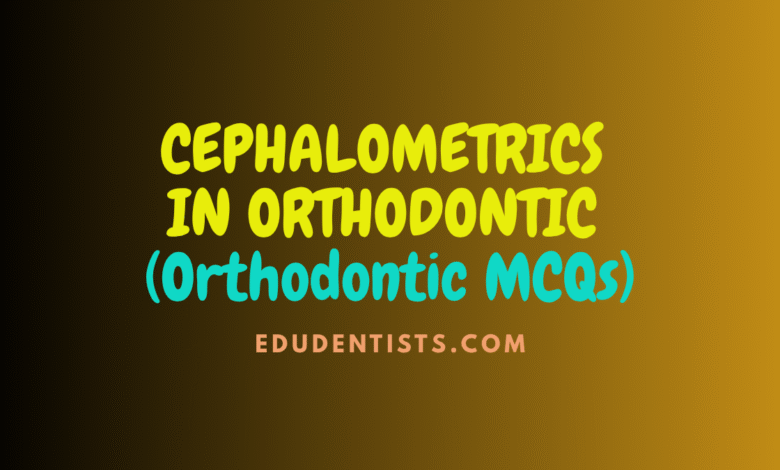CEPHALOMETRICS IN ORTHODONTIC MCQs

CEPHALOMETRICS IN ORTHODONTIC MCQs
CEPHALOMETRICS IN ORTHODONTIC MCQs
1. With age gonial angle tends to:
A. Increase in size
B. Decrease in size
C. First increase then decrease
D. First decrease then increase
2. Maxilla ante inclination means:
A. There is an anterior open bite
B. Patient will exhibit horizontal growth pattern
C. Forward rotation of the maxilla
D. There is a deep bite
3. ANB angle in severe class 2 malocclusion is:
A. Negative
B. Small
C. Normal
D. Large
4. Most stable and commonly used plane for super imposition of lateral cephalogram in the study of growth of a child is
A. S-N plane
B. Frankfort plane
C. Mandibular plane
D. Occlusal plane
5. Which of the following reference plane is used in McNamara’s analysis?
A. FH plane
B. Basion–nasion plane
C. Both of the above
D. None of the above
6. Most suitable method for analyzing pre- and post-myofunctional therapy is
A. Pitchfork analysis
B. Burstone analysis
C. Rickets growth prediction
D. Using template analysis
7. Which of the following is a postero-anterior cephalometric analysis?
A. Harvold
B. Grummon
C. Sassouni
D. Margolis
8. Orthodontic/orthopedic therapy influences:
A. Saddle angle
B. Gonial angle
C. Articular angle
D. Base plane angle
9. Growth estimation, orthodontic treatment planning, and surgical prediction can be assessed by:
A. Quick cephalometrics
B. Dentofacial planner
C. Both a and b
D. None
10. Cephalometric analysis that emphasize vertical and horizontal proportions first is:
A. Harvold analysis
B. Down analysis
C. Sassouni analysis
D. Template analysis
11. Clinically examined plane is:
A. SN plane
B. Palatal plane
C. Frankfort plane
D. Bolton’s plane
12. Airway analysis is an integral part of:
A. TOMAC analysis
B. Ricketts analysis
C. McNamara’s analysis
D. Moore’s proportional analysis
13. Centroid of mandibular symphysis:
A. Point B
B. Point D
C. All of the above
D. None of the above
14. Which of the following relationships can be assessed by cephalometrics?
A. Tooth to tooth
B. Bone to bone
C. Tooth to bone
D. All of the above
15. Superimposition in longitudinal cephalometric studies best demonstrates the growth of:
A. Plane and point
B. Structures farthest from plane and point
C. Structures nearest to plane and point
D. All of the above
16. Cephalometrics is used for:
A. Treat malocclusions
B. Study growth changes
C. Aid in diagnosis and caste analysis
D. Both B and C
17. What does ANB angle of 2 degrees indicate?
A. Favorable relationship of maxillary alveolar base to mandibular alveolar base
B. Favorable relationship of mandible to cranium
C. Poor cranial growth
D. Upright incisors
18. Cephalometric study reveals:
A. Maxilla during growth is translated in a downward and forward direction
B. Mandibular growth stops after maxillary growth
C. Both A and B
D. Cranial base growth determines mandibular growth
19. In cephalometry:
A. Frankfort plane passes horizontally from nasion through porion
B. Frankfort plane passes horizontally from nasion to Bolton point
C. Frankfort plane passes horizontally from orbitale to the superior aspect of external auditory meatus
D. Frankfort plane passes vertically from orbitale through the maxillary canine
20. Parameters used to diagnose a long face syndrome patient in cephalometrics is
A. Jarabak ratio
B. Saddle angle
C. SNA
D. SNB
21. Angle formed between occlusal plane and F-H plane is:
A. 7
B. 9.3
C. 20
D. 0
22. Following cephalometric landmarks is not a midline structure:
A. Nasion
B. Menton
C. Sella
D. Gonion
23. Horizontal plane that is most commonly used for cephalometric orientation is:
A. SN plane
B. FH plane
C. Occlusal plane
D. Palatal plane
24. Mid-point amidst sella to Bolton point is:
A. Condylion
B. Nasion
C. Basion
D. Registration point





